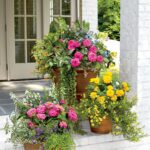Transforming outdoor spaces into modern garden design and layouts has become increasingly popular in recent years. With a focus on sleek lines, minimalist features, and sustainable practices, modern garden design offers a fresh take on traditional landscaping. From incorporating sustainable elements to maximizing space, this article explores the key components of modern garden design and layout.
Modern garden design and layouts are characterized by clean lines, innovative use of materials, and a focus on functionality. Embracing the principles of minimalism and sustainability, modern gardens offer a harmonious balance between man-made structures and natural elements. Whether you have a small urban space or a larger suburban yard, there are endless possibilities for creating a modern oasis that enhances your outdoor living experience.
In this article, we will delve into the essential elements of modern garden design and layout, including the selection of plants that complement the contemporary aesthetic, the integration of sustainable practices, the importance of hardscaping, creating outdoor living spaces for relaxation and entertainment, tips for maximizing space in smaller areas, and the role of lighting in enhancing the overall ambiance. Additionally, we will showcase stunning case studies to inspire your own modern garden transformation.
Key Features of Modern Garden Design
Modern garden design has become increasingly popular in recent years, offering a departure from the traditional style of gardening. The key features of modern garden design set it apart from other styles and are a crucial element in creating a contemporary outdoor space.
Key features of modern garden design include:
- Minimalistic layout and clean lines
- Emphasis on functionality and purpose
- Use of geometric shapes and patterns
- Integration of technology and smart garden solutions
- Mixing of different materials such as wood, metal, and concrete
One of the defining characteristics of modern garden design is its emphasis on minimalism. This style focuses on simplicity and clean lines, with an emphasis on open spaces and a clutter-free environment. Modern gardens also prioritize functionality, ensuring that every element serves a purpose and contributes to the overall design.
Incorporating geometric shapes and patterns is another key feature of modern garden design. This can be achieved through the use of structured plant beds, hardscaping elements such as paving or decking, or even the layout of outdoor furniture.
The integration of technology and smart garden solutions is also a hallmark feature, allowing for automated irrigation systems, outdoor lighting controlled via smartphone apps, or even sustainable energy sources like solar panels. By combining these key features, modern garden design offers a unique and visually striking outdoor space that reflects contemporary lifestyles.
Choosing the Right Plants for a Modern Garden
Choosing the right plants for a modern garden is crucial in creating a sleek and sophisticated outdoor space. Modern garden design emphasizes clean lines, minimalism, and the integration of natural and man-made elements. When selecting plants for a modern garden, it is important to consider their form, color, texture, and how they will complement the overall design aesthetic.
Key Features of Modern Garden Design
In a modern garden, plant selection tends to favor a more architectural and structural look. This means incorporating plants with strong shapes, such as ornamental grasses, succulents, and sculptural shrubs. Additionally, a limited color palette is often preferred in modern gardens, focusing on shades of green with accent colors for visual interest.
Incorporating Sustainability in Modern Garden Layouts
Another essential aspect of choosing the right plants for a modern garden is considering sustainability. Selecting native or drought-tolerant plants not only reduces the need for excessive watering but also supports local biodiversity. By using sustainable planting practices, modern gardens can contribute to ecological balance while maintaining their chic and contemporary appearance.
| Aspect | Description |
|---|---|
| Plant Selection | Favoring architectural and structural plants such as ornamental grasses and succulents. |
| Color Palette | Preference for limited color palette focusing on shades of green with accent colors. |
| Sustainability | Consideration of native or drought-tolerant plants for ecological balance. |
Incorporating Sustainability in Modern Garden Layouts
Use of Native Plants
One key aspect of creating a sustainable modern garden is the use of native plants. These are plants that are naturally adapted to the local climate and soil conditions, reducing the need for excessive watering, fertilizers, and pesticides. By choosing native plants for your modern garden, you can promote biodiversity and support the local ecosystem.
Water Conservation Techniques
Another important factor in sustainable modern garden design is water conservation. Implementing techniques such as drip irrigation, rainwater harvesting, and selecting drought-tolerant plants can significantly reduce water usage in your garden. Additionally, incorporating permeable paving or gravel areas can help with water absorption and prevent runoff.
Composting and Organic Practices
To further enhance sustainability in modern garden layouts, consider implementing composting systems and organic gardening practices. Composting kitchen waste and yard debris can provide nutrient-rich soil amendments for your plants, while avoiding chemical fertilizers and pesticides can minimize harm to the environment.
By incorporating these sustainability practices into your modern garden layout, you can not only create a beautiful outdoor space but also contribute to environmental conservation efforts. From conserving water to promoting biodiversity, sustainable gardening provides numerous benefits for both the environment and your own wellbeing.
The Importance of Hardscaping in Modern Garden Design
Hardscaping is an essential element of modern garden design, as it helps to create structure, define spaces, and add visual interest to the outdoor environment. Incorporating hardscape features such as pathways, patios, and retaining walls can enhance the overall aesthetic appeal of a garden while also serving functional purposes. Here are some key elements to consider when integrating hardscaping into a modern garden layout:
- Pathways: Utilizing materials like pavers, gravel, or concrete, pathways can provide a sense of direction and movement within the garden. Whether straight or meandering, well-designed paths can lead visitors through different areas of the garden while also adding texture and contrast.
- Patios and Decks: Creating designated areas for outdoor seating and entertainment is an important aspect of modern garden design. Patios and decks constructed from materials like stone, wood, or composite decking can extend living spaces outdoors and provide a platform for furniture, grills, fire pits, and other amenities.
- Retaining Walls: In gardens with varying elevations or terraced landscapes, retaining walls are crucial for preventing soil erosion while also adding visual appeal. These structural elements can be constructed using materials that complement the overall design scheme and help define different areas within the garden.
Incorporating hardscaping into modern garden layouts allows for the creation of functional outdoor spaces that are visually striking and easy to maintain. By carefully selecting and integrating these features into the design plan, homeowners can elevate their outdoor environment while maximizing both form and function.
Creating Outdoor Living Spaces in Modern Garden Layouts
In modern garden design, creating outdoor living spaces has become an essential aspect of the layout. The purpose of these spaces is to provide a comfortable and functional area for relaxation, entertaining guests, and even dining outdoors. To achieve this, homeowners can incorporate elements such as comfortable seating, dining areas, and outdoor kitchens into their garden layout.
When designing outdoor living spaces in a modern garden, it’s important to consider the flow and connectivity between the different areas. This could involve seamlessly integrating the outdoor space with the indoor living area or creating designated zones for specific activities. Additionally, incorporating natural elements such as water features, fire pits, or even a pergola can enhance the ambiance and create a more inviting atmosphere.
One key trend in modern garden design is the concept of “bringing the indoors out,” which involves creating a cozy and stylish space that mirrors the comforts of an indoor living room but is located in the garden. This can be achieved through the use of high-quality furniture, decorative elements like rugs and throw pillows, and strategic placement of plants and greenery to create a sense of intimacy.
Ultimately, creating outdoor living spaces in modern garden layouts allows homeowners to fully maximize their outdoor space and enjoy it as an extension of their home.
Tips for Maximizing Space in a Modern Garden
Modern garden design often focuses on creating a sleek and minimalist look while maximizing the use of space. With limited outdoor areas in urban settings, it’s important to make the most out of every square foot available. Here are some tips for maximizing space in a modern garden.
First, consider utilizing vertical space. Vertical gardening allows you to grow plants upwards, whether it’s by using trellises, wall-mounted planters, or hanging baskets. This not only adds visual interest to your garden but also frees up ground space for other purposes such as seating or walking areas.
Secondly, multi-functional furniture and features can help maximize space in a modern garden. For example, built-in benches with storage underneath can provide seating while also serving as a place to keep gardening tools or outdoor cushions. Similarly, a dining table that can double as a fire pit during cooler evenings saves space and adds versatility to your outdoor area.
Lastly, creating defined zones within the garden can help make the most of the available space. This could mean separating an outdoor dining area from a lounging area with different flooring materials or using hedges or tall grasses to partition off specific spaces for different purposes. By clearly defining various areas within the garden, you can optimize each zone for its intended use without wasting valuable space.
The Role of Lighting in Modern Garden Design
When it comes to modern garden design, lighting plays a crucial role in creating ambiance and extending the usability of outdoor spaces. In recent years, there has been a surge in the popularity of incorporating various lighting elements to enhance the overall appeal of gardens. Whether it’s for entertainment purposes or simply to illuminate certain features, lighting can truly transform a garden into a mesmerizing and functional area.
One key aspect of incorporating lighting into modern garden design is to focus on energy-efficient and sustainable options. LED lights, solar-powered fixtures, and low-voltage systems are all excellent choices when it comes to minimizing energy consumption while still achieving stunning visual effects. Additionally, using timers and motion sensors can further optimize the use of garden lighting by ensuring that lights are only activated when needed.
In terms of design, strategic placement of lights can highlight specific areas such as walkways, water features, or focal points within the garden. Soft ambient lighting can create a cozy and inviting atmosphere for outdoor gatherings, while task lighting can serve practical purposes such as illuminating cooking or dining areas in an outdoor kitchen or dining space. With proper planning and creativity, the right combination of lighting elements can bring modern garden designs to life after dark.
| Aspect | Example |
|---|---|
| Energy-Efficient Lighting Options | LED lights, solar-powered fixtures |
| Strategic Placement | Highlighting walkways, water features |
| Practical Purposes | Illuminating cooking or dining areas |
Case Studies
One stunning example of modern garden design and layout is the High Line in New York City. This elevated linear park was built on a historic freight rail line, and it seamlessly integrates nature with urban architecture.
The planting design features a mix of native and adapted plants that thrive in the city environment, creating a unique and sustainable green space. The use of innovative hardscaping elements, such as concrete pathways and seating areas, adds to the contemporary feel of the park.
Another impressive case study in modern garden design is the Gardens by the Bay in Singapore. This futuristic garden showcases a combination of sustainable practices and cutting-edge technology.
The famous Supertree Grove features vertical gardens that act as air intake and exhaust systems for the conservatories, demonstrating how functional sustainability can be incorporated into modern garden layouts. The use of lighting is also notable, as the gardens come alive at night with a mesmerizing light show, blending natural beauty with modern architectural elements.
The Oasia Hotel Downtown in Singapore is a prime example of how outdoor living spaces can be integrated into modern garden designs. The hotel’s facade is covered with lush greenery, creating a vertical garden oasis within the bustling city center.
The incorporation of outdoor terraces and sky gardens provides guests with tranquil retreats high above the urban landscape. This case study emphasizes the importance of creating multi-functional spaces within modern garden layouts, where people can relax, socialize, and connect with nature amidst an urban backdrop.
Conclusion
In conclusion, modern garden design and layouts offer a unique and innovative approach to outdoor spaces, combining the best elements of natural beauty, sustainability, and functional design. By incorporating key features such as clean lines, minimalistic plant selections, and sustainable practices, a modern garden can become a serene oasis that enhances the overall aesthetic of any property.
When it comes to bringing modern garden design to life in your own space, it’s essential to carefully consider the layout, plant selection, hardscaping elements, outdoor living areas, and lighting. By integrating these aspects thoughtfully and cohesively, you can create a stunning outdoor environment that fulfills both aesthetic and practical needs.
Ultimately, modern garden design allows for endless possibilities in creating a space that reflects contemporary tastes while also meeting individual needs and preferences. With careful planning and attention to detail, anyone can transform their outdoor space into a captivating modern garden that brings joy and tranquility for years to come.
Frequently Asked Questions
What Is Modern Garden Style?
Modern garden style refers to a design approach that emphasizes clean lines, minimalism, and the use of contemporary materials. This style often includes geometric shapes, sleek surfaces, and a focus on functionality. Modern gardens typically prioritize simplicity, innovation, and a seamless integration of outdoor and indoor living spaces.
How Do You Modernize a Garden?
To modernize a garden, one can start by removing any outdated or cluttered elements and replacing them with sleek, minimalist features. This could involve adding clean-lined furniture, incorporating modern sculptures or art installations, and using low-maintenance plants with architectural appeal. Additionally, updating hardscape materials such as concrete or metal can help create a more contemporary look.
What Is a Modern Landscape Style?
A modern landscape style is characterized by its emphasis on simplicity, bold forms, and an overall sense of minimalism. It often includes open spaces, clean lines, and the use of technology or cutting-edge materials to create visually striking outdoor environments.
Plant choices may include mass plantings of grasses or structural plants such as succulents to enhance the overall modern aesthetic of the landscape. Overall, the goal is to create a cohesive, functional landscape that complements the architecture of the surrounding structures while embracing contemporary design principles.

Welcome to my gardening blog! I am passionate about plants and enjoy sharing my knowledge and experiences with others. In this blog, I will write about everything related to gardening, from tips on how to get started to updates on my own garden projects.





